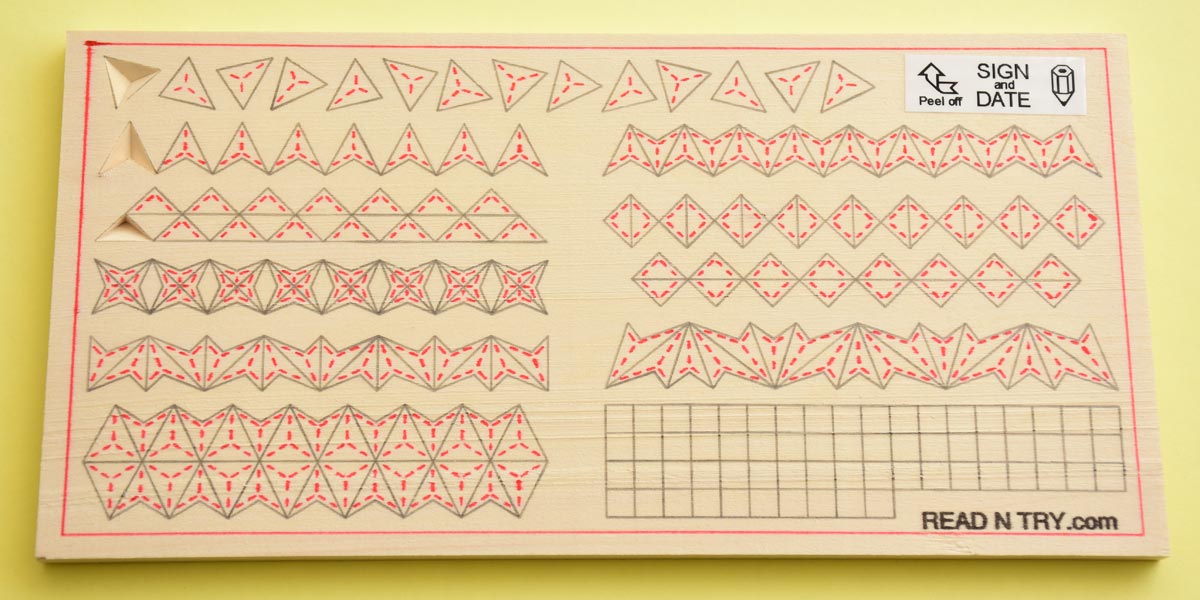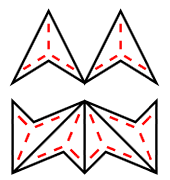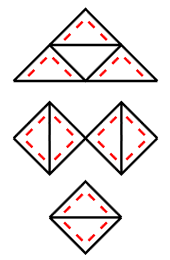The highest quality basswood is used to manufacture these chip carving practice boards. This board includes multiple classic Old-World-Style chip carving patterns that require vertical cuts on two sides of a chip. This board can be carved using both modern and old styles of chip carving with your regular chip carving knife. This board is great for advanced and for experienced chip carvers. We pre-carve examples so you could see how different chips should be carved. Click on the image below to enlarge the pattern.

$16 | Free Shipping to US & Canada
 The board features mostly 4-corner chips arranged in various ways; these are traditional chips used in old-world style of chip carving where vertical cuts are used on two sides of the chip. The board also includes standard 3-corner chips on top, so you could “feel” the board. The last pattern on the left shows an example of how 3-corner chips and 4-corner chips may be nicely combined.
The board features mostly 4-corner chips arranged in various ways; these are traditional chips used in old-world style of chip carving where vertical cuts are used on two sides of the chip. The board also includes standard 3-corner chips on top, so you could “feel” the board. The last pattern on the left shows an example of how 3-corner chips and 4-corner chips may be nicely combined.
Notice how we draw the chips with vertical cuts: the dash lines are placed very close to the solid lines of the chip borders on the internal side of the chip to indicate vertical cuts. These cuts are done by holding a chip carving knife vertically about 90 degrees to the board. Experiment with the vertical cuts by holding the knife at 85, 80, or 70 degrees, so they become almost vertical, to achieve different effects.
 The third row of patterns features an interesting kind of chips: three corner chips where two sides are done using vertical cuts. These traditional chips are relatively easy to carve; they have a unique play of light and shade. Not sure what is the right English name for those chips but the translated name from Russian is “Splitters” (“Сколыши”).
The third row of patterns features an interesting kind of chips: three corner chips where two sides are done using vertical cuts. These traditional chips are relatively easy to carve; they have a unique play of light and shade. Not sure what is the right English name for those chips but the translated name from Russian is “Splitters” (“Сколыши”).
Board Size: 4 x 8 x 1/4″ (10 x 20 x 0.6 cm). The practice board is 1/4″ (6 mm) thick; it is designed for carving with the angles up to 65 degrees. With the steeper carving angles and/or undercutting it is possible to cut through the board; use solid material under the board while carving to avoid accidents. We found that the board thickness is perfect to avoid/unlearn a heavy undercutting habit/mistake. The board includes a grid area at the bottom right. You could repeat some existing patterns there or draw a new design or two to practice more.
The board surface is flat but not polished; you may see some very minor tool marks from a thickness/surface plainer on the board. If a surface is sanded the wood fibers will keep some abrasives from sand paper that may dull a chip carving knife faster; therefore we don’t sand the boards. Please contact learn@readNtry.com if you would like to get a sanded practice board as a custom order.
We transfer the chip carving patterns using our computerized system to achieve the ultimate precision. A regular mechanical pencil is used for drawing the chip borders (so it is easy to clean-up) and a red pen for highlighting the middle dash lines.
Don’t forget to sign and date your practice board; it may be helpful when you find your carved board decades later. Read a story about how the chip carving practice board project started, tips, feedback, comments and see examples of carved practice boards.

Leave a Reply